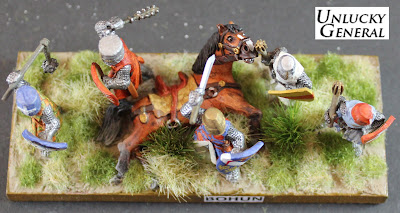Casualty Markers II: Modelling
 Inspired by a fellow blogger Bigredbat who I follow, I knew it was time to think about casualty markers for morale purposes. The thing with these sorts of game additions is that we often leave them as a last resort or after thought but I determine to get them underway as I went to ensure I didn't need to make a dozen at once at the end which for me would be tedious.
Inspired by a fellow blogger Bigredbat who I follow, I knew it was time to think about casualty markers for morale purposes. The thing with these sorts of game additions is that we often leave them as a last resort or after thought but I determine to get them underway as I went to ensure I didn't need to make a dozen at once at the end which for me would be tedious. I have taken two of Essex Miniatures caparisoned horses because I had plenty spare: most of their accompanying knights falling outside of the 1260s. Essex also caste in a flexible white metal which I hazard has a lead content unlike more modern pewter castings. In spite of their thickness, these horses can be manipulated with enough force so I modelled one marker with the rider dead and the horse beginning to get back up from the fall whilst the other knight is knocked out from crashing off his killed and fallen steed.
I have taken two of Essex Miniatures caparisoned horses because I had plenty spare: most of their accompanying knights falling outside of the 1260s. Essex also caste in a flexible white metal which I hazard has a lead content unlike more modern pewter castings. In spite of their thickness, these horses can be manipulated with enough force so I modelled one marker with the rider dead and the horse beginning to get back up from the fall whilst the other knight is knocked out from crashing off his killed and fallen steed. The knights themselves are again Essex Miniatures but were foot knights with their stands removed with cutting pliers and trimmed back, then filed. Once more, pliability made them capable of flattening out a little with the face-down knight still graping his now buckled shield. His less fortunate comrade (or perhaps an enemy) is face up with his head slightly turned and quite obviously punctures several times from archery.Essex Miniatures design mounted knights of the thirteenth century with the saddles cast onto the figure, not the horse, which left some green-stuffing to be done for saddle, stirrups and leathers - duly done.
The knights themselves are again Essex Miniatures but were foot knights with their stands removed with cutting pliers and trimmed back, then filed. Once more, pliability made them capable of flattening out a little with the face-down knight still graping his now buckled shield. His less fortunate comrade (or perhaps an enemy) is face up with his head slightly turned and quite obviously punctures several times from archery.Essex Miniatures design mounted knights of the thirteenth century with the saddles cast onto the figure, not the horse, which left some green-stuffing to be done for saddle, stirrups and leathers - duly done. The arrow shafts were made from reed straw taken from my yard broom and the feathers are thin plastic card. The bond achieved with Humbrol plastic cement is quite effective for fixing feather to shaft but I will try plastic rod and a liquid cement next time for a finer result. Like the rest of my army, I am waiting until I have sculpted the terrain before finishing the bases to ensure a match.
The arrow shafts were made from reed straw taken from my yard broom and the feathers are thin plastic card. The bond achieved with Humbrol plastic cement is quite effective for fixing feather to shaft but I will try plastic rod and a liquid cement next time for a finer result. Like the rest of my army, I am waiting until I have sculpted the terrain before finishing the bases to ensure a match. I almost never work with balsa for basing these days but the ability to hand craft circles easily saw my return to the product - a shape I always prefer for command figures and markers. With my usual magnetic basing beneath, they are quite sturdy and will be more so once the bases are fully sculpted, textured and painted. One of these chaps as you can see from this photo series is an old paint job touched up (a Teutonic knight) but the other casualty is a known historical figure.
I almost never work with balsa for basing these days but the ability to hand craft circles easily saw my return to the product - a shape I always prefer for command figures and markers. With my usual magnetic basing beneath, they are quite sturdy and will be more so once the bases are fully sculpted, textured and painted. One of these chaps as you can see from this photo series is an old paint job touched up (a Teutonic knight) but the other casualty is a known historical figure. William le Blund (Blunde), 6th and last baron of Ixworth in Suffolk was killed at Lewes and was in fact one of the few barons recorded to be - the majority of the fallen either taken from the rank and file or the lesser gentry if you will and not high born or famous enough to have deserved a mention by the chroniclers of the day.
William le Blund (Blunde), 6th and last baron of Ixworth in Suffolk was killed at Lewes and was in fact one of the few barons recorded to be - the majority of the fallen either taken from the rank and file or the lesser gentry if you will and not high born or famous enough to have deserved a mention by the chroniclers of the day.


Comments